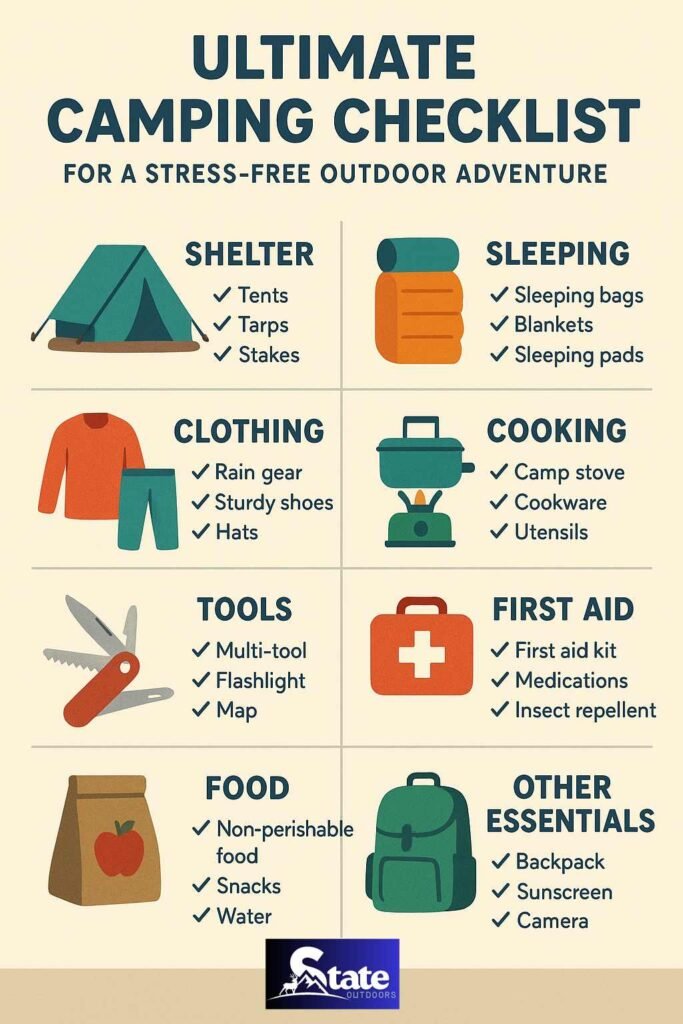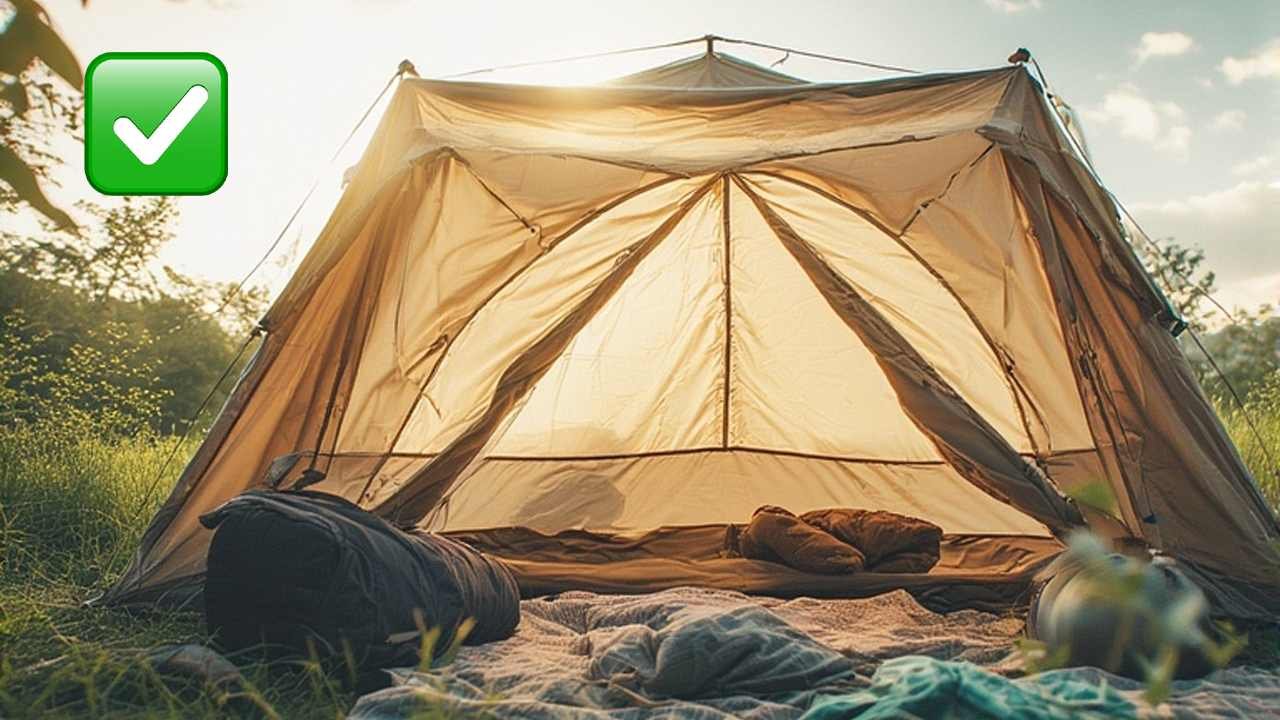Ultimate Camping Checklist ✅ for a Stress-Free Outdoor Adventure
Embarking on a camping trip is an incredible way to reconnect with nature, but thorough preparation is the key to a comfortable and enjoyable experience. A well-planned packing strategy ensures you have all the essentials without overpacking, allowing you to focus on the serenity of the outdoors. This definitive guide provides a meticulously organized camping checklist, designed to be your trusted resource for packing with confidence. From your shelter and sleep system to camp kitchen essentials and personal items, we’ve structured this information into clear, actionable lists to guarantee you don’t forget a single thing for your upcoming outdoor adventure.
Furthermore, a successful trip hinges on more than just gear. This guide also delves into crucial pre-departure planning, campsite safety protocols, and savvy packing tips to keep you safe, organized, and ready to fully immerse yourself in the natural world. For instance, if your adventure includes destinations with specific seasonal considerations, it’s wise to research local conditions, much like you would check the detailed hunting season guidelines for California before a trip. By using this article as your foundation, you can create a personalized checklist that evolves with your experience, ensuring every journey into the wild is seamless and memorable.

Pre-Trip Planning: Your Blueprint for Success
Before you even start packing, a little foresight can prevent most common camping headaches. Proper planning is your first line of defense against unexpected challenges and is the true secret to a stress-free outing.
- Assess Your Campsite: Your destination dictates your gear list. Is it a developed campground with picnic tables, running water, and restrooms, or a primitive site where you must be fully self-sufficient? Always check the specific amenities and regulations of your chosen site beforehand.
- Decipher the Weather: Look up the forecast for the entire duration of your trip, preparing for the lowest low and highest high temperatures predicted. If rain is a possibility, your list must include waterproof outer layers and perhaps an extra tarp.
- Plan Your Meals: Create a simple meal plan for your trip. Deciding what you’ll eat for each meal helps you shop efficiently and pack only the necessary kitchen gear, saving space and reducing waste.
- Secure Your Reservation: Many public and private campgrounds require advance bookings. Platforms like Recreation.gov for public lands or Hipcamp for private sites are excellent resources. Don’t forget to bring your reservation confirmation.
- Understand Wildlife Protocols: Determine if you are camping in bear country. If so, you will need to plan for proper food storage using bear-proof canisters or lockers and commit to keeping a clean campsite free of food odors.
The Complete Camping Checklist
This section breaks down all essential gear into logical categories. Use these tables as a master list, customizing them based on your trip’s specific needs, duration, and destination.
Shelter & Sleep System
A good night’s rest is non-negotiable for an enjoyable camping experience. Your shelter and sleep system are the foundation of your comfort outdoors.
Shelter & Sleeping Gear
| Item | Essential or Optional | Notes & Considerations |
|---|---|---|
| Tent with rainfly | Essential | Ensure it’s sized for your group and season-appropriate. |
| Tent footprint or ground tarp | Optional | Protects the tent floor from moisture and abrasion. |
| Mallet or hammer | Essential | For driving tent stakes securely into the ground. |
| Sleeping bag | Essential | Choose one with a temperature rating suitable for the climate. |
| Sleeping pad or air mattress | Essential | Provides insulation from the ground and cushioning. |
| Pillows | Essential | Camping-specific or from home for comfort. |
| Repair kit (tent pole, mattress) | Essential | A simple sleeve or patch kit can save a trip. |
| Headlamp or flashlight | Essential | Hands-free light is crucial for setting up camp after dark. |
Camp Kitchen & Cooking Gear
The camp kitchen is the heart of many campgrounds. Being well-organized here makes meal prep easy and enjoyable.
Kitchen & Cooking Essentials
| Category | Essential Items | Optional & Luxe Items |
|---|---|---|
| Cooking Appliances | Camp stove and fuel, matches/lighter, fire starters (if fires permitted) | Camp grill, Dutch oven, portable coffee maker |
| Cookware & Utensils | Pot, frying pan, sharp knife, cutting board, cooking utensils (spatula, spoon), camp wash bin | Griddle, kettle, coffee press |
| Food Storage | Cooler with ice, food storage containers/bags, trash bags | Bear canister (if required), large water jugs, plastic bins for organization |
| Dining | Plates, bowls, mugs, knives/forks/spoons, insulated water bottle | Tablecloth with clips, reusable wine glasses |
| Cleaning | Biodegradable soap, sponge/scrubber, dish towel, paper towels | Small broom and dustpan, collapsible drying rack |
Clothing & Footwear
Packing the right clothing is all about versatility and preparation for changing conditions. Layering is a fundamental concept for outdoor comfort.
Clothing & Footwear Packing List
| Item Type | Essential Picks | Weather-Specific Add-Ons |
|---|---|---|
| Upper Body | Moisture-wicking T-shirts, long-sleeve shirt (sun/bug protection), lightweight fleece or jacket | Insulated jacket, warm hat, gloves (cold); rain jacket/windbreaker (rain) |
| Lower Body | Quick-drying pants and/or shorts | Long underwear, waterproof pants (cold/rain) |
| Footwear | Hiking boots/shoes suited to terrain, camp sandals/shoes | Snow boots (cold), water shoes (swimming) |
| Accessories | Moisture-wicking underwear, synthetic or wool socks, sleepwear | Sun hat, sunglasses, swimsuit |
Health, Hygiene & Safety
Staying clean, healthy, and safe allows you to fully enjoy your time outdoors. This category is often overlooked but is critically important.
Health & Safety Supplies
| Category | What to Pack | Pro Tips |
|---|---|---|
| First-Aid | Adhesive bandages, gauze, antiseptic wipes, medical tape, blister treatment, pain relievers, any personal medications. | Use a pre-assembled kit and check it before each trip to replace used or expired items. |
| Sun & Bug Protection | High-SPF sunscreen, SPF lip balm, insect repellent. | Reapply sunscreen frequently, especially after swimming or sweating. |
| Hygiene | Toothbrush & toothpaste, quick-dry towel, hand sanitizer, toilet paper, unscented soap/shampoo. | Use unscented products to avoid attracting insects and wildlife. |
| Tools & Repair | Multi-tool, duct tape, extra cordage, water filtration system. | A multi-tool is invaluable for quick fixes and meal prep. |
| Emergency & Navigation | Headlamp, map/compass or GPS device, whistle, portable power bank. | Don’t rely solely on your phone; always have a physical map and compass as a backup. |
Campsite Extras & Personal Items
These items elevate your campsite from basic to comfortable and functional, while personal items are those final, critical details.
Campsite & Personal Essentials
| Campsite Comfort & Furniture | Personal Items & Entertainment |
|---|---|
| • Camping chairs | • Cash, credit cards, and ID |
| • Folding table (if no picnic table) | • Cell phone and portable charger |
| • Lantern for ambient light | • Campsite reservation and permits |
| • Sunshade or screen house | • Binoculars, book, journal |
| • Hammock | • Lawn games, frisbee, playing cards |
Campsite Setup and Safety Protocols
Arriving at your campsite is just the beginning. A systematic approach to setup and safety ensures a smooth and secure experience from start to finish.
- Site Inspection: Upon arrival, carefully scan your site for potential hazards like poison ivy, ant beds, unstable branches, or uneven terrain.
- Strategic Setup: Pitch your tent on high, level ground, at least 15 feet upwind from your fire pit or grill. Clear a 3-foot area around the tent of any leaves, dry grass, or other flammable debris.
- Fire Safety: If you build a campfire, never leave it unattended. Always keep a bucket of water and a shovel nearby for emergencies, and ensure the fire is completely extinguished—cold to the touch—before you leave the site or go to sleep.
- Carbon Monoxide Awareness: Never use fuel-burning appliances like heaters, lanterns, or grills inside a tent, vestibule, or camping vehicle. These devices can produce lethal levels of carbon monoxide, an odorless and colorless gas. Use only battery-operated lights in and around your tent.
- Food Storage: To avoid attracting wildlife, never leave food or trash unattended. Store all food, trash, and scented items (like toiletries) in a locked vehicle, a designated metal food locker, or an approved bear-proof container.
Pro Packing & Organization Tips
An organized pack leads to an organized camp. These simple strategies will save you time and frustration.
- Use Clear Plastic Bins: Organize your gear by category (e.g., kitchen, tools) in clear, stackable plastic bins with lids. You can see what’s inside at a glance, they protect gear from dust and moisture, and they make loading and unloading your vehicle a breeze.
- Create a “First-Night” Box: Pack a single bin with all the items you’ll need immediately upon arrival: tent, mallet, headlamps, water, and some snacks. This prevents you from having to unpack everything just to get started.
- Master Your Cooler: A quality cooler is a game-changer. Pre-chill your cooler and all food and drinks before loading them. Keep drinks and food in separate coolers to limit opening the main food cooler. Keep the cooler in the shade and covered with a blanket for maximum efficiency.
- Practice Leave No Trace: Plan to leave your campsite cleaner than you found it. Separate garbage from recyclables and dispose of them properly in campground receptacles. This preserves the natural beauty for wildlife and future campers.
What NOT to Bring Camping
Knowing what to leave behind is as important as knowing what to pack. Avoid bringing these items to minimize your impact and maximize safety.
- Single-Use Plastics & Wet Wipes: Opt for reusable water bottles and towels instead. Wet wipes, even “flushable” ones, are notorious for causing severe damage to septic systems and the environment.
- Strongly Scented Items: Perfumes, scented lotions, and aerosol sprays can attract bugs and, more importantly, wildlife like bears. It’s best to use unscented hygiene products while camping.
- Glass Containers: Glass is heavy and poses a serious safety risk if broken. Transfer food and drinks into plastic or other durable, lightweight containers.
- Your Entire Electronics Collection: Part of camping’s appeal is unplugging. Leaving expensive gadgets at home protects them from damage and frees you to engage with your surroundings. A phone for photos and emergencies is sufficient for most.
- Non-Camping Specific Heaters: Small, portable electric heaters can be a major fire hazard inside tents or near flammable materials. They are best left at home.
Conclusion: Your Adventure Awaits
With this ultimate camping checklist as your guide, you are now equipped to tackle the great outdoors with confidence and calm. The goal is not to pack every single item listed, but to use these comprehensive tables to build a personalized kit that matches your adventure style. Remember, the most successful camping trips are built on a foundation of good planning, the right gear, and a respectful attitude toward nature. So gather your lists, check your bins, and get ready to create unforgettable memories under the stars.

